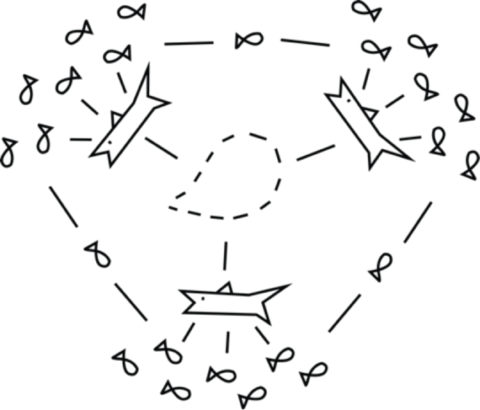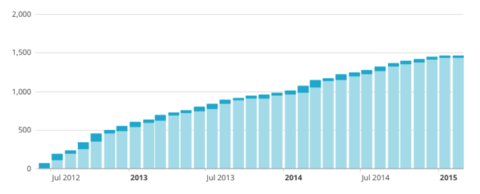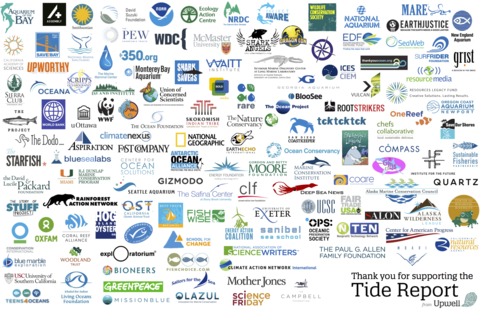How an email strengthened a community
From Anchorage on the 12th of October 2011, Kieran Mulvaney emailed this to Rachel Weidinger:
“I keep coming to the idea of a weekly or bi-weekly email newsletter, sent to as wide a mailing list of researchers, bloggers, journalists, foundation folks etc as we can pull together, with links to stories, videos etc, summaries of the major stories, and even a little editorializing. And while this may seem inside baseball, another case of the community speaking to itself, it’s a means to an end, a way to a) help ensure that we get sent latest news and info and included in the proverbial loop; and b) help our work be retweeted and forwarded by others with a sympathetic and interested audience.”
It was Kieran’s idea that would, with the visionary help of the Waitt Foundation, become the Tide Report. But we made one significant tweak to Kieran’s proposal: rather than being written for an audience of professional ocean wonks, our primary audience for the Tide Report was this: subscribers who would drive more attention, in measurable ways, to the crisis the ocean is facing.
It’s been nearly three years since we sent our very first Tide Report on June 5, 2012, and, as you can see, much has changed. As Upwell’s flagship missive, it’s the primary way we’ve kept in touch with ocean influencers and run our distributed network campaigns. It was never just an email newsletter, it was so much more.
What is the Tide Report?
The Tide Report’s primary purpose is to drive spikes in online attention to critical ocean issues. It was built to supply influencers who love the ocean with shareable content and easy pathways to amplify that content so that we could transform the conversation about the crisis the ocean faces.
While it was intended as a campaign tool, the Tide Report also served another important purpose - it helped ocean communicators see the work of their peers and understand how they fit into a broader movement. It cultivated a sense of “Team Ocean” and provided the members of that team with models for successful communication.
We’ve written 226 Tide Reports (as of Monday, March 2). Over the years, the style has changed somewhat, but one thing has remained consistent: with each Tide Report, we not only shared the hottest ocean news, but we asked our readers to amplify and share. The purpose was to use the email as a way to help Team Ocean see itself, connect you with the work of your ocean-loving peers, show you what stories, ideas and content get people talking online, and promote sharing, generosity and transparency within our movement. By amplifying the best ocean-y content at the times it mattered most, you showed the power of our collective voice to drive change across issue and organizational boundaries.

Through the Tide Report, Team Ocean amplifies great ocean content.
The impact of the Tide Report as a campaign tool to transform online conversation is reflected in our online conversation analyses like our “State of the Online Conversation” reports about ocean acidification and overfishing. But we rarely talk about the impact of the Tide Report as a community and capacity building tool, so I want to do that today.
Who reads the Tide Report?
While we aren’t at liberty to share the names and email addresses of our readers, we can share some basic stats.
Keep in mind the Tide Report doesn’t fit neatly into any email newsletter box. It lives in the vast gray space between a neighborhood listserv and an advocacy list. Our subscriber list is small in numbers (approximately 1500), but large in reach. We hand-built our list, targeting people who controlled channels where they can influence the public. Many of our subscriptions came out of in-person meetings, one-on-one collaborations, and attendance at meeting and conferences.

Tide Report list growth shows a consistent increase over time. (Light blue = existing subscribers, dark blue = additional subscribers.
Most of our subscribers (81%) are based in the United States. A significant portion of our readers have subscribed with their work addresses (31% end in .org, 5% in .gov, and 4% in .edu). Many additional subscribers are unaffiliated individuals who just have a passion for the ocean, or ocean conservation professionals that subscribed with their personal email addresses. Below is a graphic showing the breadth and depth of Team Ocean’s representation. All these organizations, institutions, and companies get the Tide Report too!

These are your colleagues on Team Ocean. With this network, we helped amplify attention to what matters.
What that community thought of the Tide Report
We’ve heard from Team Ocean that the Tide Report increased network resiliency, and helped many of the less influential, but just as passionate members of the team make their communications more successful. Last month, we surveyed our Tide Report subscribers, asking them if and how working with Upwell has changed the way they work or has connected them with resources. What we heard reflects the diversity of our readership:
While it’s unlikely that the this scientist’s activity (inspired by our content) directly spiked a conversation, the timely context we provided surely strengthened their communications:
“As a scientist, I am often disconnected with what is happening in the social media sphere, and the Tide Report has been a great way to understand what the general public perceives as current ocean-related issues.”
A secondary goal of the Tide Report was to continuously build social media skills through useful examples:
“Each Tide Report helped me learn about new ocean issues- and I'm not very adept at ocean media, so your guidelines on what to amplify, etc. really helped."
Many of our readers saw that by amplifying the content we suggested and provided, they not only helped draw attention to ocean topics, but they increased engagement on their own channels:
“We use many of the articles and images that come out of the Tide Report for our social media. By doing so, we've seen more engagement within our community members.”
Another secondary goal of the Tide Report was to hold up a mirror to Team Ocean, so its members could see each other and discover new peers:
“I was always surprised at the little nuggets of information I found in the Tide Report and would often find new partners to reach out to.”
We would often hear that reading the Tide Report became part of our readers’ workflow:
“My coworkers and I look forward to the Tide Report. Whenever one of us discovers something new or something catches our eye (every email there is something) we discuss it in our weekly meeting and then pass on the information to guests and volunteers we work with.”
Curation is a resource-intensive process, and we tried to efficiently provide a resource to Team Ocean by sharing the results of our curation widely:
“There's a TON of ocean news that I have to sift through daily, and every time I saw the Tide Report delivered to my inbox, I knew that there'd be some reliable, thought-provoking gems to add to the larger conversation.”
We didn’t target just ocean conservation professionals - many of the influencers on our list are interested in other topics, and we’ve put oceans on their radar.
“I loved the straightforward way the Tide Report showed what your key messages were, and directly asked readers to help amplify them. Additionally, while the ocean was not an area of environmental concern that I was very tuned in to prior to discovering Upwell, it's now something I am much more attuned to when I read the news, discuss conservation issues, and think about my impact on the environment.”
Tide Report engagement and greatest hits
If you’ve been a Tide Report reader for a while, you may remember some of our greatest hits. Recently, I pored through engagement data from our Tide Reports going back to November 2013. Since we usually talk about what resonates with the whole Internet, I thought it might be fun to narrow my lens and look at what resonated the most with our readers.
Here are the top links (measured by number of unique clicks) in Tide Reports since November 2013:
- Upwell’s Buzzfeed article “Why you need to care about the Empty Oceans Act.” - February 7, 2014
- The sea froze so fast that it killed thousands of fish instantly - January 17, 2014
- The link to the job description when we were hiring a Tide Report writer - February 24, 2014
- 23 Fantastic Images Of The Incredibly Weird Things In The Ocean - October 27, 2014
- MBARI’s captivating video about the Black Seadevil anglerfish - November 25, 2014
- The succinct and well-researched Buzzfeed article, 13 Reasons the Ocean Might Never Be The Same - January 17, 2014
- This mind-boggling and upsetting video of a super trawler at work, shared on Facebook by Ocean Defender Hawaii - December 4, 2014
- David Shiffman expressing consternation in Scientific American at the emerging trend of shark riding - March 5, 2014
- Lessons from 2014 from The New York Times’ social media desk - January 23, 2015
- Pacific Standard delves into why Blackfish became so popular - January 24, 2014
These are the Tide Reports that were opened by the largest percentage of subscribers (excluding the first few months of the Tide Report, when open percentages were high but our list was very small). Note that the first three aren’t actually traditional Tide Reports, and are associated with the Upwell Transitions of 2013 and 2015, which goes to show that when you might go away, people pay attention. Numbers eight and nine below (and number 3 above) show that employment opportunities increase engagement. Even if you can’t hire someone, sharing other jobs is generous and a great way to spark interest!
- Not a Tide Report (2013 Survey) - February 7, 2013
- Tide Report: A time of transition - January 28, 2013
- Bittersweet news from the Upwell team - January 12, 2015
- Tide Report: A high-tech solution for plastic pollution? Also: Meet the Mermaid Death Squad - March 28, 2013
- Tide Report: Upwell lessons to share, a hot OA video, NYT sustainable fish debate, and more. - March 5, 2013
- Tide Report: In which we encourage you to NOT get any attention today. - April 19, 2013
- Tide Report: Ocean acidification music video, Grocers reject GMO Salmon, and more - March 21, 2013
- Wanted: Tide Report writer. Anchor-shaped referral bonus! - February 24, 2014
- Tide Report: Upwell’s hiring (again); UNESCO sites to drown; river otter conquers alligator - March 7, 2014
- Tide Report: Ocean education from TED, Sharkinar, CCAMLR, and all the lionfish you can eat. - July 10, 2013
Over time, our Tide Report has experienced unprecedented engagement rates from our readers. Our open rate has hovered consistently around 35% for the past three years, and our click rate has stayed consistent at 9-10%. These rates compare extremely favorably to nonprofit industry averages (13% open rate and 2.9% click rate), as reported by M+R and NTEN in their annual email benchmarks study. Because our list is small, and targeted toward people with high investment in our mission, we’d expect higher engagement rates than donor or action appeals from a traditional nonprofit. It’s still great to see.
What the Tide Report has taught me
So what have I learned from all of this? And what can the Tide Report community do to continue this work after the Tide Report ceases to be?
One of the challenges and biggest lessons I learned in my years writing the Tide Report was how to think about what will resonate. I had to think about what would resonate with the internet at large, a huge grab bag of people - most of whom have a very limited understanding of ocean conservation issues - as well as what would resonate with our readers. I had to inspire our ocean-literate readers to share, but encourage them to share content that would inspire those less familiar with these issues to share too.
Finding that balance was always tough. And sometimes our readers would share the stuff that was the nerdiest and wonkiest, instead of the stuff I had handpicked because it was shareable. Sometimes that totally nerdy thing was going to be a viral hit, and sometimes it just going to get 100 views and disappear. I wanted our readers to understand that we were carefully selecting things that we thought would resonate with a broader audience. One of the critical tools in my practice was our “Why We Choose” list - our curation criteria for what to amplify in the Tide Report. We strongly encourage people to create their own lists, to keep themselves in check and ensure that resources are put into the things that are most likely to succeed.
I also learned that Team Ocean is always eager to learn more. Our Tide Reports that focused on sharing lessons, hosting webinars, reporting back on surveys received incredibly high engagement from our readers. I encourage those on Team Ocean to share, share, share. Write sharing into your grant proposals! Budget time for packaging what you’ve learned. When campaigns or outreach efforts fail, give yourself time to think about why, and don’t be afraid to tell the story publicly. Sharing has been part of Upwell’s brand since day one. Find out how to make it part of yours. Let’s make ocean conservation open source.
Don’t be afraid to ask! I think there’s a culture of fear around asking people to share or retweet your stuff. But how else are you going to get your message out? Our entire model was based on a request to amplify, and while our readers didn’t always amplify everything we sent out, they did amplify the things that resonated with them. But they may not have amplified had we not asked. As we often say, do as Shiffman does (he is the king of “please RT”).
And, finally, when it comes to email lists, small and mighty is better than big and weary. Focus in on who your biggest supporters are. Who’s amplifying your message, and can they be recruited to be part of your team? Cultivate your network in a way that feels like that neighborhood listserv. We send out postcards or care packages to our BFFs. Even if we work on the internet, we live in real life. Let’s not forget that our “lists” are bunches of individual humans, with individual passions, pursuits, fears and regrets.
What have you learned from the Tide Report, and how will you start working differently? Tell us your reactions in the comments.
Add a comment